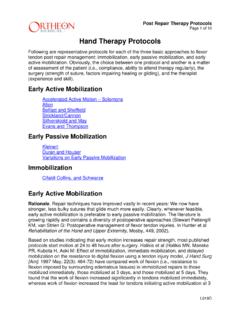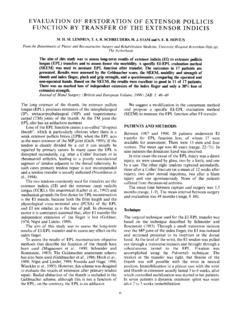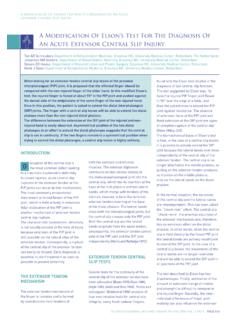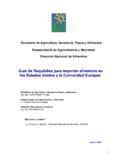Transcription of Depuytren Disease: Anatomy, Pathology, …
1 TH E JO U R N A L O F BO N E & JO I N T SU R G E R Y J B J R GVO L U M E 8 9 - A NU M B E R 1 JA N U A R Y 2 0 0 7DU P U Y T R E N DI S E A S E: AN A T O M Y, PA T H O L O G Y, PR E S E N T A T I O N, A N D TR E A T M E N TDupuytren disease : anatomy , pathology , Presentation, and TreatmentBy Ghazi M. Rayan, MDAn Instructional Course Lecture, American Academy of Orthopaedic SurgeonsThe disorder called Dupuytren disease has been recognized for approximately 400 years. Its presentation, although seemingly rather constant, is actually extremely variable, depending on which structures are involved. A thorough knowledge of palmar fascial anatomy is essential to the understanding of Du-puytren disease .
2 There have been re-cent advances in the pathophysiology of Dupuytren disease , and these have added to our knowledge of this disorder but have not yet changed its treatment. There are two distinct clinical entities, classic Dupuytren disease and atypical, so-called non-Dupuytren palmar fas-cial disease1,2. These two types differ in presentation, etiology, treatment, and prognosis. Authors of future epidemio-logical and outcome studies should not confuse these two clinical entities. Sur-gical treatment is the conventional and most widely used method of managing Dupuytren earliest published reference to the disorder that was later to be called Dupuytren disease was by Felix Platter, who in 1614 described a case, attributing the deformity to a flexor tendon contracture3.
3 In 1777 Henry Cline recognized that the disorder in-volved the palmar fascia, in 1822 Sir Astley Cooper advocated closed fasciot-omy as a treatment for the condition, and in 1831 Guillaume Dupuytren gave a detailed anatomic and pathologic de-scription of the disease and demon-strated a surgical case in Paris that earned him the disease eponym4. By 1900 there were at least 256 publica-tions related to Dupuytren disease and at least eight books on the subject2, , gender, geography, and ethnicity influence the disease preva-lence, which has been reported to be as low as 2% and as high as 42%12-14. Men are more likely to have it than women (a ratio of nine to one), and the overall incidence increases with age, with the frequency in women catching up to that in men later in life15.
4 The disease is common in Scandinavia, Great Brit-ain, Ireland, Australia, and North America. It is uncommon in southern Europe and South America and rare in Africa and China16, disease is associated with diabetes18-20. Burge et al. reported a higher risk of Dupuytren disease in al-coholics, smokers, people with hyperc-holesterol, and patients infected with human immunodeficiency virus21-23. There is controversy regarding a rela-tionship between Dupuytren disease and seizure disorders24,25. The etiology of Dupuytren disease remains controver-sial as well, but inflammation, trauma, neoplasia, and genetics have been im-plicated as factors26-31. The evidence is strongest for at least a genetic predispo-sition.
5 There is a clearly increased inci-dence in relatives of patients with Dupuytren disease , and there has been at least one report of identical twins with the disease13,32. There seems to be an autosomal dominant transmission with variable radial, ulnar, and central apo-neuroses, palmodigital fascia, and digital fascia are all part of the palmar fascial complex (Fig. 1)33. These struc-tures are involved to varying degrees in Dupuytren disease . Each structure can be subdivided. The radial aponeu-rosis has four components: the thenar fascia (an extension of the central apo-neurosis), the thumb pretendinous band (small or absent), the distal com-missural ligament, and the proximal commissural ligament34.
6 The ulnar apo-neurosis consists of the hypothenar Disclosure: The author did not receive grants or outside funding in support of his research for or preparation of this manuscript. He did not receivepayments or other benefits or a commitment or agreement to provide such benefits from a commercial entity. No commercial entity paid or directed,or agreed to pay or direct, any benefits to any research fund, foundation, educational institution, or other charitable or nonprofit organization withwhich the author is affiliated or associated. TH E JO U R N A L O F BO N E & JO I N T SU R G E R Y J B J R GVO L U M E 8 9 - A NU M B E R 1 JA N U A R Y 2 0 0 7DU P U Y T R E N DI S E A S E: AN A T O M Y, PA T H O L O G Y, PR E S E N T A T I O N, A N D TR E A T M E N Tmuscle fascia (an extension of the cen-tral aponeurosis), the pretendinous band to the small finger (always present and very substantial), and the abductor digiti minimi confluence, which is enveloped by the fibers of the sagittal band35,36.
7 The central aponeurosis is the core of Dupuytren disease activity. It is a triangular fascial layer with its apex proximal. Its fibers are oriented longi-tudinally, transversely, and vertically. The longitudinal fibers fan out as pre-tendinous bands in the three central digits, and each bifurcates distally. Each bifurcation has three layers37. A superficial layer inserts into the dermis, a middle layer continues to the digit as the spiral band, and a deep layer passes almost vertically and dorsally. The transverse fibers make up the natatory ligament located in the distal part of the palm and the transverse ligament of the palmar aponeurosis. The transverse lig-ament of the palmar aponeurosis is proximal and parallel to the natatory ligament and deep to the pretendinous bands.
8 Its distal, radial extent is the proximal commissural ligament. The transverse ligament of the palmar apo-neurosis gives origin to the septa of Legueu and Juvara, which protect the neurovascular structures and provide an additional proximal pulley to the flexor tendons. The vertical fibers of the central aponeurosis are the minute ver-tical bands of Grapow and the septa of Legueu and Juvara. The vertical bands are numerous, small, strong, and scat-tered along the palmar fascial complex and are most abundant in the central aponeurosis38. The vertical septa of Legueu and Juvara are deep to the pal-mar fascia and form fibro-osseous compartments33,39,40. There are eight septa, one radial and one ulnar for each finger41.
9 They form seven compart-ments of two types: four flexor septal canals that contain the flexor tendons and three web space canals that contain the common digital nerves and arteries and the lumbrical muscles (Fig. 2). These septa are inserted in a soft-tissue confluence that consists of five struc-tures: the A1 pulley, the palmar plate, the sagittal band, the interpalmar plate ligament, and the septa of Legueu and Juvara (Fig. 3). The fascial structures in the palmodigital region are complex. The middle layer of the bifurcated pre-tendinous band spirals on its axis nearly 90 , and the peripheral fibers run verti-cally adjacent to the metacarpopha-langeal joint capsule40. They continue distally deep to the neurovascular bun-dle and natatory ligaments and emerge distal to the natatory ligaments to con-tinue as the lateral digital sheet.
10 This spiral band therefore is the connection between the palmar and digital fascial structures. The proximal fibers of the natatory ligaments run in a transverse plane, but the distal fibers form a u and continue longitudinally along both sides of the digit, forming the lateral digital sheet. The lateral digital sheet therefore has deep and superficial con-tributions from the spiral band and the natatory ligament. The neurovascular bundle in the digit is surrounded by four fascial structures: the Grayson liga-ment (palmar), the Cleland ligament (dorsal), the Gosset lateral digital sheet laterally, and the Thomine retrovascular fascia medially and myofibroblast is the offending cell in Dupuytren disease .










